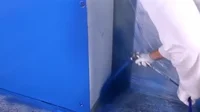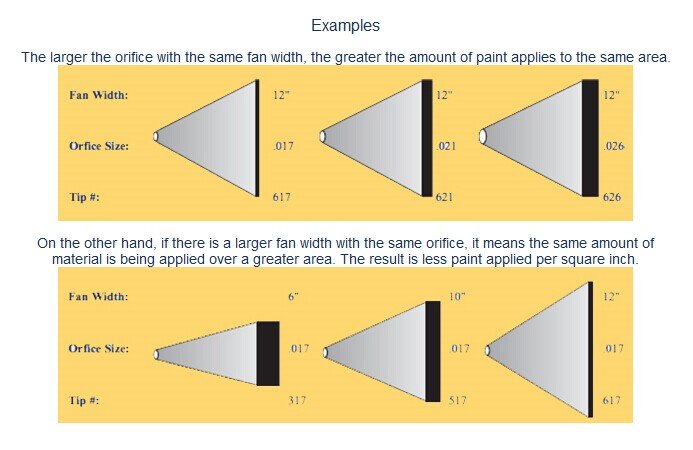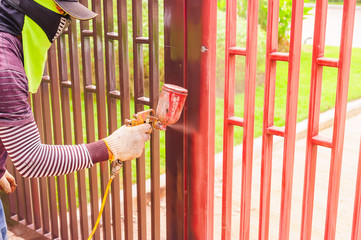Choosing the right paint sprayer tip size is one of the most important steps in doing your next painting project right. You don’t want to waste time, paint, or money in labor charges by selecting the wrong tip size.
In this guide, we share a handy paint sprayer tip size you can always refer to when selecting sprayer tips for your spraying projects. Different sprayers need different tip sizes, and you want to always get it right for the best painting results for each project.

Paint Sprayer Tip Size Chart
The chart below is a great reference when buying paint sprayer tips for your upcoming spray painting work. The most important thing is not to memorize it but rather understand what the figures mean and how they guide you in picking the right tip.

What Does the Tip Orifice Do?
The tip orifice is the tiny hole that lets out the paint onto the surface you are painting. A smaller tip orifice means less paint comes through it, while a larger orifice means that more paint flows through it onto the surface.
Besides letting the paint out, the orifice determines how much control you have over the fan width and how deep each coating is. As the tip orifice enlarges due to wear and tear, the fan width enlarges, and you end up wasting more paint sprayed over an even smaller area.
What Does Fan Width Mean?
The fan width of a paint sprayer tip is the width in inches of the patch or fan that the tip sprays when you hold it 12 inches from the surface you are painting.
If different tips have the same fan width but different orifice sizes and are used at the same distance from the surface, you will apply more coating on the surface as the size of the orifice increases.
When using different tips with the same orifice size but varying fan widths, you apply the same amount of coating over a larger area as the fan width increases.
Use sprayer tips with narrow fan widths (such as 3xx, 2xx, and 1xxx) when you want to spray narrow surfaces such as fences, cabinets, trims, doors, and staircase railings.
Use sprayer tips with label numbers like 6xx and 5xx for larger surfaces, such as exterior and interior walls.
Note that some manufacturers may use the term “spray width” to refer to fan width.
Paint Sprayer Tip Sizes
Paint sprayer tips come in a wide range of sizes, which is good for users because of the vast number of coatings you can apply with a range from the thinnest to the heaviest coatings with the highest viscosity.
The tip’s size should guide you on the type of paint you can use, and there are instances of cross-over or overlap where you can use the same range of orifice sizes for various types of paint or material.

For example, thin orifices are best for spraying light materials, such as water sealers, clear coat lacquer, and varnish. Large-sized orifices are best for spraying heavy materials such as fire retardants/intumescents, block fillers, and two packs.
With tip sizes ranging from .009 to .011, you can spray thin materials such as clear coat lacquer and varnish.
Tip sizes between .009 and .013 are suitable for thin materials such as shellac, water sealers, and transparent stains.
Spray tips with orifice sizes between .012 and .014 are suitable for spraying materials of medium thickness, such as clear acrylics and water-borne lacquers.
Tips with orifice sizes ranging between .013 and .015 are suitable for spraying materials with medium thickness, such as solid stain, polyurethane, low-VOC varnish, and oil-based enamels.
Other orifice sizes for medium-thickness materials such as interior latex and primer latex include sizes .015 to .017. Tip orifice sizes .017 to .019 are suitable for primer oils and exterior latex.
Smooth elastomeric fall within the heavy materials category and are best sprayed with tip orifices with sizes .021 to .025. The same size range is suitable for spraying heavy latex.
Block fillers and rough elastomeric fall within the heavy materials category, and you can spray them using tips with orifice sizes between .025 and .039. Intumescents can range in thickness from heavy to extremely heavy and are suitable for orifice sizes between .017 and .039.
Check the manufacturer’s recommendations on what sprayer tip size you should use for each type of paint or spray material, as well as what paint or material is most suitable with your selected tip orifice size.
Choosing the wrong type of material will mean losing money with wasted labor, material, spray tip, and time.
For example, if you use a thin-size spray tip with a thick or heavy material such as an intumescent, you will ruin the tip, waste your time, labor, and money as the material will keep clogging the tip and wearing it down.

How To Determine Spray Tip Size
Since most airless sprayer tip manufacturers indicate the recommended tip sizes, you won’t have a problem determining what tip size you should use for a particular material.
However, this is not always straightforward, and you might have to do some calculations based on the 3- or 4-digit number that appears on the tip.
What Do the Numbers on the Tip Mean?
There are two aspects to note about tip sizing. The size of a spray tip comprises the fan width and the size of the orifice itself, the small hole that lets out the spray material.
Most spray tip manufacturers embed a 3-digit number on the tip to indicate the fan width and the hole size. The first digit in the set stands for half the fan width, expressed in inches. The remaining two digits indicate the orifice size in thousandths of an inch.
For example, an airless sprayer tip with the number 315 on it means that its fan width is 6 inches, which you arrive at by multiplying the first digit by 2 (3×2). When you position the tip at 12 inches perpendicularly from the surface, this sprayer tip has a spray width of 6 inches.
The same sprayer tip with the number 315 on it means that it has an orifice size of 0.015 inches, which you arrive at by dividing the last two digits by 1000 (15/1000).
The spray tip number may also indicate a third aspect – the spray angle. The spray angle is the angle that the sprayer ejects the spraying material on the surface. To obtain this angle, add a zero in front of the first digit. For a 315 sprayer, the spray angle is 30 degrees.
In some cases, you may come across sprayer tips with a 4-digit label. For example, a spray tip labeled 12xx indicates that it has a big fan width and is most suitable for spray painting new and large construction walls.
Conclusion
Spray painting is a great way to save time and money, but you have to pick the right sprayer tip for each project. If you are spraying thick materials like fire retardants, be sure to pick a sprayer tip with a larger orifice.
Sprayer tips with smaller orifices are best for lighter materials such as varnish and clear coat lacquer. Using the wrong sized tip will lead to losses in labor charges, time, and money spent on frequently damaged tips. Choose the correct tip size for the right spray material.
